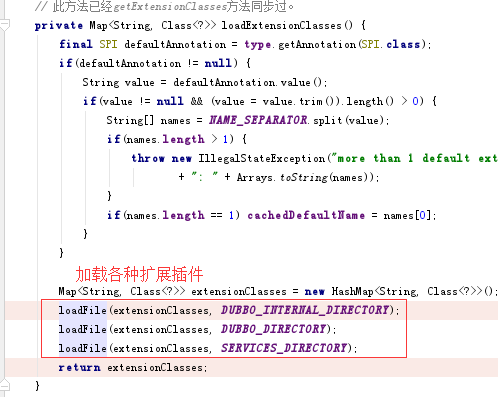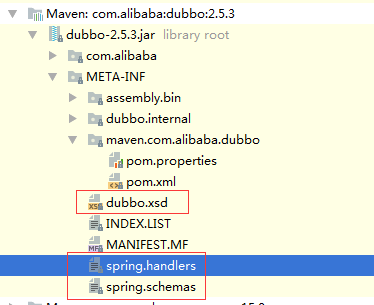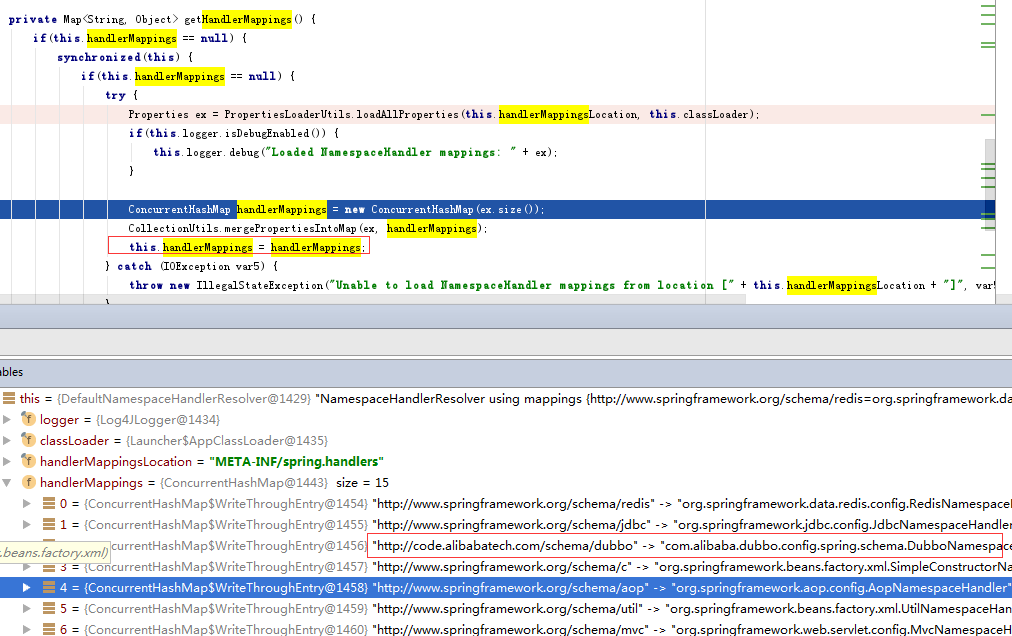String applicationConfig = "consumer-applicationContext.xml";
ApplicationContext context = new ClassPathXmlApplicationContext(applicationConfig);
UserInfoService userInfoService = (UserInfoService) context.getBean("userInfoService");
//负载均衡的处理是一个典型的懒加载模式,只有在第一次调用接口时,才进行负载均衡的处理。
System.out.println(userInfoService.sayHello("zhangsan"));
1.在进入sayHello的调用时,堆栈信息和帧代码如下


其中Constants.LOADBALANCE_KEY的值是“loadbalance”,而Constants.DEFAULT_LOADBALANCE的值是“random”,每个接口(reference)均可以灵活配置一个均衡方式,默认不配置的情况下都是random的。
不配置loadbalance时,是random的模式。
2.假如当前的loadbalance设置了leastactive时,它是如何把名字和类LeastActiveLoadBalance的实例关联起来呢?
3.首先它在com.alibaba.dubbo.rpc.cluster.loadbalance目录下实现了4种均衡方式,如下:
ConsistentHashLoadBalance:一致哈希
LeastActiveLoadBalance:最久不使用
RandomLoadBalance:随机
RoundRobinLoadBalance:顺序循环
注:上1点中的loadbalance返回的则是上述的其中一个均衡策略类实例。
4.其它dubbo实现了一套类似spi的服务加载机制如下:


private void loadFile(Map> extensionClasses, String dir) {
String fileName = dir + type.getName();
try {
Enumeration urls;
ClassLoader classLoader = findClassLoader();
if (classLoader != null) {
urls = classLoader.getResources(fileName);
} else {
urls = ClassLoader.getSystemResources(fileName);
}
if (urls != null) {
while (urls.hasMoreElements()) {
java.net.URL url = urls.nextElement();
try {
BufferedReader reader = new BufferedReader(new InputStreamReader(url.openStream(), "utf-8"));
try {
String line = null;
while ((line = reader.readLine()) != null) {
final int ci = line.indexOf('#');
if (ci >= 0) line = line.substring(0, ci);
line = line.trim();
if (line.length() > 0) {
try {
String name = null;
int i = line.indexOf('=');
if (i > 0) {
name = line.substring(0, i).trim();
line = line.substring(i + 1).trim();
}
if (line.length() > 0) {
Class clazz = Class.forName(line, true, classLoader);
if (! type.isAssignableFrom(clazz)) {
throw new IllegalStateException("Error when load extension class(interface: " +
type + ", class line: " + clazz.getName() + "), class "
+ clazz.getName() + "is not subtype of interface.");
}
if (clazz.isAnnotationPresent(Adaptive.class)) {
if(cachedAdaptiveClass == null) {
cachedAdaptiveClass = clazz;
} else if (! cachedAdaptiveClass.equals(clazz)) {
throw new IllegalStateException("More than 1 adaptive class found: "
+ cachedAdaptiveClass.getClass().getName()
+ ", " + clazz.getClass().getName());
}
} else {
try {
clazz.getConstructor(type);
Set> wrappers = cachedWrapperClasses;
if (wrappers == null) {
cachedWrapperClasses = new ConcurrentHashSet>();
wrappers = cachedWrapperClasses;
}
wrappers.add(clazz);
} catch (NoSuchMethodException e) {
clazz.getConstructor();
if (name == null || name.length() == 0) {
name = findAnnotationName(clazz);
if (name == null || name.length() == 0) {
if (clazz.getSimpleName().length() > type.getSimpleName().length()
&& clazz.getSimpleName().endsWith(type.getSimpleName())) {
name = clazz.getSimpleName().substring(0, clazz.getSimpleName().length() - type.getSimpleName().length()).toLowerCase();
} else {
throw new IllegalStateException("No such extension name for the class " + clazz.getName() + " in the config " + url);
}
}
}
String[] names = NAME_SEPARATOR.split(name);
if (names != null && names.length > 0) {
Activate activate = clazz.getAnnotation(Activate.class);
if (activate != null) {
cachedActivates.put(names[0], activate);
}
for (String n : names) {
if (! cachedNames.containsKey(clazz)) {
cachedNames.put(clazz, n);
}
Class c = extensionClasses.get(n);
if (c == null) {
extensionClasses.put(n, clazz);
} else if (c != clazz) {
throw new IllegalStateException("Duplicate extension " + type.getName() + " name " + n + " on " + c.getName() + " and " + clazz.getName());
}
}
}
}
}
}
} catch (Throwable t) {
IllegalStateException e = new IllegalStateException("Failed to load extension class(interface: " + type + ", class line: " + line + ") in " + url + ", cause: " + t.getMessage(), t);
exceptions.put(line, e);
}
}
} // end of while read lines
} finally {
reader.close();
}
} catch (Throwable t) {
logger.error("Exception when load extension class(interface: " +
type + ", class file: " + url + ") in " + url, t);
}
} // end of while urls
}
} catch (Throwable t) {
logger.error("Exception when load extension class(interface: " +
type + ", description file: " + fileName + ").", t);
}
}
5.每个均衡策略类均实现了select接口,通过该接口从多个可用的后端服务中返回其中一个服务。
Invoker select(List> invokers, URL url, Invocation invocation) throws RpcException;



